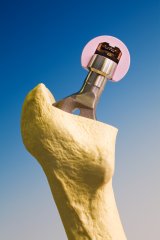Great potential for wireless sensor systems through transponder technology
Transponder systems are becoming increasingly important in daily life. Whereas the simplest versions are used as identification or storage media, additional information on objects or their environmental conditions can be collected by adding sensor systems. Innovative systems and concepts can be used to monitor goods for example, particularly in the commercial and logistics sector. On the technical side, this means that miniaturized, autonomous measuring systems can be realized as well as complex implantable diagnostic systems in medical technology.
Work at the Fraunhofer Institute for Photonic Microsystems IPMS focuses on the use of RFID technology for microsystems. Radio Frequency Identification (RFID) is a wireless data and energy transmission technology. It allows small, energy self-sufficient systems to be developed for a variety of applications. These wireless systems can then work passively as measuring systems. The transponder platform developed at the Fraunhofer IPMS combines a RFID tag with sensors and a microcontroller. The Institute can offer suitable solutions for all frequency ranges from 125 kHz (LF) through to 900 MHz (UHF).
At this year’s »Sensors Expo & Conference« between June 4 and 6, 2013 in Rosemont, IL, USA, the Fraunhofer IPMS will be presenting transponder systems with integrated pressure, moisture and temperature sensors (booth 726).
Intelligent hip prostheses
Implants have been used for decades in medicine to restore functions of the human body or to relieve acute pain. Mechanical parts are normally implanted to ensure stability or replace bones. These implants remain in the patient’s body either for the rest of their life or at least for a longer period of time. The most common example of these implants is an artificial hip joint.
Thanks to the development of microsystems technology, we are now able to equip implants with measuring and monitoring functions. But the supply of energy inside the body remains a key problem. The use of transponder technology is therefore an ideal solution for long-term implants. The energy needed for the measurements is transmitted to the implant from the outside by means of magnetic coupling, without any wires. A platform was developed at the Fraunhofer IPMS on the basis of this technology that supplies the electronic circuitry in the implant with energy and at the same time can export the measured data. Hans-Jürgen Holland, deputy director of the Wireless Microsystems business unit, explains: »Our technology is based on a low-frequency transponder circuit. The chosen carrier frequency of 125 kHz guarantees that sufficient energy is supplied to the implant. The circuit contains not only the transponder components but also a freely programmable microcontroller with connections for digital and/or analogue sensors and actuators.« There are many possible applications. For example, this solution can be used for a continuous measurement of the temperature, pressure, acceleration or pH value. A simultaneous signal processing and analysis of the measured results in the implant is also possible.
Fraunhofer IPMS will be exhibiting one such intelligent implant at the Sensors Expo using a hip prosthesis equipped with a sensor system to check whether it is still well anchored in the bone as an example.
Temperature monitoring in switchgear by RFID transponders
But transponders are used in not just medical technology; miniaturized, autonomous measuring systems can also be realized with them in the technical field. One practical example of such an application is monitoring the temperature on busbars in switch cabinets. To this end, Ultra-High-Frequency (UHF) RFID transponders from the Fraunhofer IPMS with temperature sensors are installed in the switch cabinets from the Luxemburg firm of KÖHL AG. This kind of measurement allows the wireless and battery-free monitoring of screw connections on the busbars. If these become loose, the electric transition resistance rises, which heats up the contact point and, in extreme cases, can lead to dangerous arcing. Thanks to the sensor transponders from the Fraunhofer IPMS, this kind of development can be monitored and maintenance measures initiated in due time.
About Fraunhofer IPMS
The Fraunhofer Institute for Photonic Microsystems IPMS and its 200 employees turn over an annual research volume of 20 million euros. Fraunhofer IPMS generates more than two thirds of this production capacity out of commissions from industry and publicly financed projects in applied research. The focus of our development and production services lies in the practical industrial application of unique technological know-how in the fields of (optical) micro-electromechanical systems [MEMS, MOEMS]. Fraunhofer IMPS uses scientific know-how, application experience and customer contacts as well as modern equipment and clean room infrastructure. Fraunhofer IPMS covers a broad spectrum of industrial applications. Our services range from initial conception to product development, right down to serial pilot production – from a single component to a complete system solution.
 Fraunhofer Institute for Photonic Microsystems
Fraunhofer Institute for Photonic Microsystems